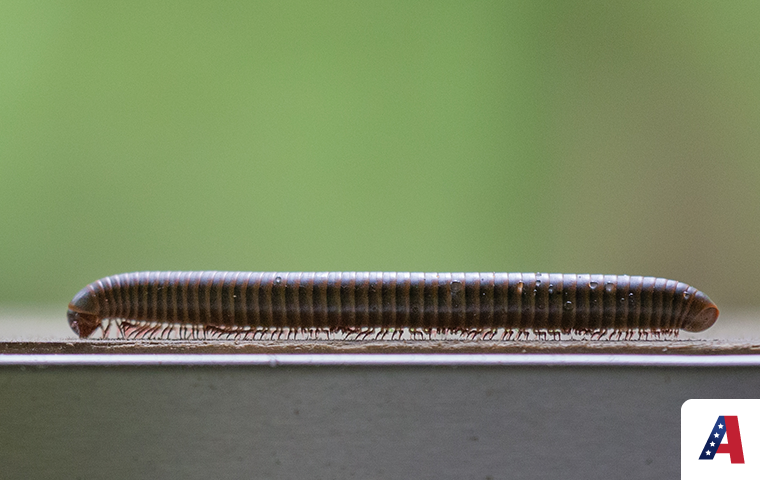There are two pests that call Middle Tennessee home that might give spiders a run for their money in "fear factor". So many are fearful of spiders, with their eight, creepy legs, but centipedes and millipedes boast way more than that. These two pests aren't necessarily dangerous, although centipedes can bite, they are not pests you want hanging around your home. And while there are a lot a similarities between these two arthropods, it is how they are different that you will want to keep in mind when dealing with these pests. Here is a quick comparison between these two bugs and some tips on how you can keep them out of your home.
How millipedes and centipedes are similar.
-
The two bugs get mistaken for each other quite often, because they both have a lot of legs. Though centipede means "100-footed," the number of legs varies from one centipede to the next. An adult centipede can have between 30 and around 350 legs. Millipedes can have up to 400 legs.
-
These two creatures both share an affinity for moisture and can be found in moist damp places. If the ground around a home is too dry or too saturated, both millipedes and centipedes will be driven inside.
-
Both of these critters can climb walls and ceilings. Like all wall crawling bugs, they use thin claws to grip pores, dents and irregularities that can be almost imperceptible to the human eye.
The difference between millipedes and centipedes.
-
As we discussed above, millipedes and centipedes have a lot of legs. The difference between the two is that centipedes have one set of legs per body segment, and millipedes have two sets.
-
Millipedes are docile and will curl up into a spiral when threatened. Centipedes are a little more feisty, and are known to bite if threatened.
-
Millipedes tend to be smaller, with a rounded shell and legs that point straight down. Centipedes are flatter, and their long legs shoot out to the sides.
- Centipedes are predatory pests, while millipedes tend to feed on decaying plants.
Keeping millipedes and centipedes out.
The good news about millipedes and centipedes getting into your home is that they don't generally live long inside. That doesn't make them any less disgusting or frustrating to deal with. Sadly, these two creatures are hard to exclude naturally. You can make sure your door and window screens are in good working order, inspect your weather stripping and door sweeps, and fill in any rotted holes in your exterior walls. But it is hard to keep a bug out when it is able to scale walls and walk across ceilings. Partner with a pest control company, like All-American, to keep these pests--and a number of other bugs--out of your home. We offer home pest control services that help prevent pests getting indoors and making your home their own. Ready to stop pests? Reach out today!
Frequently Asked Questions
Are millipedes and centipedes dangerous in my home?
Neither of these pests are truly dangerous to people. Centipedes can bite, but it is rare and typically harmless. Millipedes' form of defense is a mild-smelling liquid that can irritate your skin if you handle one.
Why do I have a problem with millipedes or centipedes in my home?
Like many other pests you find in your home, millipedes and centipedes are drawn inside by moisture and a place to shelter. Common hiding spots for these pests include, basements, bathrooms and crawlspaces.
How do I know if it's millipedes or centipedes in my home?
The easiest way to tell which pest you have it to watch them. Their behavior and body shape are the two biggest clues. Centipedes have fewer legs, but are more "leggy" compared to millipedes who have far more legs, but are shorter and harder to see. Centipedes also move quite fast, while millipedes move much slower. Still not sure? Reach out to our bug pros!
Expert Pest Control in Nashville, TN & Surrounding Areas
Since 1961, All-American Pest Control has been your go-to team of trusted pest experts for homes, businesses, and home builders throughout Nashville and Middle Tennessee. Our expert team offers termite treatments, mosquito reduction, rodent removal, ant and spider control, and wasp nest removal—keeping your property protected year-round. As a local, family-owned company, we take pride in offering reliable, professional pest solutions with outstanding customer service.
We proudly serve: Acorn Hill, Ashland City, Bethel, Burns, Chapsmanboro, Charlotte, Cumberland Furnace, Cumberland Heights, Dickson, Kingston Springs, Pegram, Vanleer, Pleasant View, Bon Aqua, Slayden, White Bluff, Tennessee City, Bell Town, Cheap Hill, Craggie Hope, Shacklett, Lyles, Hickman, Bon Aqua Junction, Dickson City, and the entire Cheatham County, Dickson County, and Greater Nashville areas.
For trusted pest control in Nashville, TN, and these surrounding communities, contact All American Pest Control today! Call or text (615) 824-8814 or schedule a free home evaluation.
 1426 Reviews
1426 Reviews


